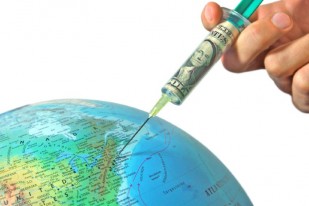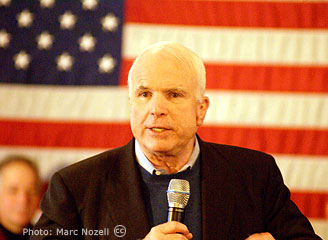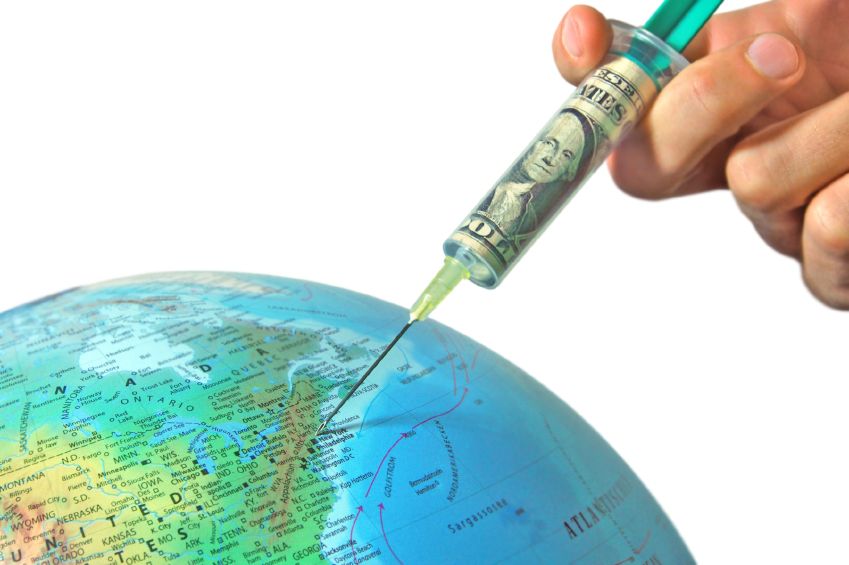
America has lost its stature as a moral leader in today’s world. The global financial system continues to unravel with devastating consequences. The escalating threat of terrorism, driven by persistent inequity between the world’s rich and poor, seems immune to military solutions. The global climate stands at the threshold of runaway changes.
What is needed is a one-stop solution that transcends traditional coalitions and national antagonisms and brings the nations of the world together in a common global project that addresses all three threats.
In short, what is needed is a coordinated global public-works program to rewire the world with clean energy.
The most immediate benefit is that such an initiative would begin to restore America’s moral leadership in today’s fractured and combative world. Every country is beginning to feel the impacts of our increasingly unstable climate — and a profound sense of desperation over America’s eight-year refusal to address the threat.
On the economic front, the globally destabilizing credit crisis, the heart-stopping plunges of the stock market, the continuing agony of job losses, and the uncertainties surrounding the price of oil are triggering paralyzing fears of a prolonged global economic recession — if not worse.
The intractable economic gap between rich and poor nations is fuelling despair, malnutrition, disease, and an ominous intensification of anti-American resentment. As a result, terrorism has replaced the old Cold War as the primary threat to international stability.
Both the financial crisis and the prospect of intensified terrorism pale before the irreversibly destructive potential of runaway climate change. Our physical environment is unraveling rapidly. As the climate continues to warm, deep oceans are heating, violent weather is increasing, the timing of the seasons is changing, and all over the world plants, insects, birds, fish, and other animals are migrating toward the poles in search of stable temperatures.
A number of the world’s most prominent climate scientists recently declared we are approaching — or have already passed — a point of no return in staving off global climate chaos. Scientists cite the rapid melting of the Arctic — as well as the recent discovery of large deposits of methane bubbling up from the perforated ocean floor off the coast of Siberia — as potential triggers for runaway changes.
This ominous confluence of global threats underscores the observation by the Brazilian diplomat Raoul Estrada that “we are all in the same boat — and there’s no way half the boat is going to sink.”
President Obama’s proposed 10-year clean energy investment of about $150 billion in the U.S. would certainly boost domestic production of windmills and solar panels and help jumpstart the U.S. economy. But it would do nothing to address global economic inequity.
Moreover, even if we in the U.S. were to dramatically cut our carbon emissions, those cuts would be overwhelmed by the coming pulse of carbon from India, China, Mexico, Nigeria, and all the developing countries which are struggling to feed and educate their people and can scarcely afford massive investments in clean energy.
On the financial front, today’s financial crisis requires the kind of public-works programs initiated in the 1930s by President Franklin Roosevelt to jump the economy out of its current state of exhaustion. Few economists believe the current capital crisis has run its course. But while FDR’s programs were national in scope, today’s globalized economy requires a global initiative to counteract a worldwide economic recession.
A global public-works program — with something like $300 billion a year in predictable North-South capital flows — would provide a much-needed ballast to counteract the wild market swings that have helped destabilize the global economy.
The relentless poverty that afflicts about two-thirds of the world’s people, moreover, requires that such projects provide tangible economic opportunities for the world’s poorest residents. Development economists tell us that every dollar invested in energy in poor countries creates far more jobs and far more wealth than the same dollar invested in any other segment of their economies. A transition to clean energy would create millions of new jobs in the developing world.
By contrast, Sir Nicholas Stern, a former chief economist at the World Bank, recently revised upward his estimate of how much it would cost the world to keep ignoring climate change; initially he said 20 percent of global gross domestic product, but he now says up to 33 percent. Explained Stern, “We underestimated the risks … we underestimated the damage associated with temperature increases … and we underestimated the probabilities of temperature increases.”
Finally the threat of escalating climate change transcends national boundaries. Nations recognize sovereignty; nature does not. If there is any issue that contains the seeds for a permanent state of conflict — over food shortages, water scarcity, and displaced populations — it is global warming.
Last year, a National Intelligence Estimate echoed the earlier findings of a group of retired generals and admirals in identifying global climate change as the greatest long-term threat to our national security.
In December, U.N. Secretary-General Ban Ki-moon called for a global green New Deal. “The economic crisis is serious,” he said. “Yet when it comes to climate change, the stakes are far higher.”
Here’s the Plan
One potential solution to our increasingly impoverished, polarized, and warming world centers on a coordinated package of policy strategies to propel a rapid global energy transition. This model is not the only way to accomplish the task. But, unlike most other approaches, it is appropriate to the scope and urgency of the challenge.
The Clean Energy Transition plan includes three strategies:
- In industrial countries, the withdrawal of subsidies from fossil fuels and the establishment of equivalent subsidies for clean energy sources;
- The creation of a large fund — perhaps through a small tax on global finance — to transfer clean energy technologies to developing countries; and,
- The incorporation within a new global climate treaty of a progressively more stringent Fossil Fuel Efficiency Standard that rises by 5 percent per year.
On the subsidy issue, the United States currently spends about $45 billion a year to subsidize carbon fuels. In the industrial countries overall, those subsidies have been estimated at about $250 billion a year.
The industrial nations should phase out subsidies for oil and coal and create equivalent subsidies for clean energy technologies. (Clearly a small portion of the U.S. subsidies must be used to retrain or buy out the nation’s approximately 40,000 coal miners.) But the lion’s share of the subsidies would still be available to the major energy companies to retrain their workers and re-tool to become aggressive developers of wind farms, solar systems, and fuel cells.
If the U.S. were to establish $45 billion in subsidies for clean energy, along with $200 billion in similar subsidies in the other industrial nations, that would mobilize an army of energy engineers and entrepreneurs — with successively more efficient generations of solar film, turbines, and tidal devices — in a burst of creativity that would rival the dot-com revolution of the 1990s.
But even if the countries of the North were dramatically to reduce emissions, those cuts would be overwhelmed by the escalating carbon emissions from large developing countries. So a second element of the plan involves the creation of a fund of about $300 billion a year for about a decade to jumpstart renewable energy infrastructures in developing countries.
That fund could be financed by any number of sources. An extremely promising mechanism involves a very small tax on international currency transactions, named after its developer, the late Nobel prize-winning economist James Tobin. (These transactions occur as a normal part of business as governments and companies exchange yen for dollars and dollars for euros.) Today, the commerce in currency transactions exceeds $1.5 trillion a day. A tax of a quarter-penny on a dollar on those transactions would net out to about $300 billion a year, which could go toward wind farms in India, fuel-cell factories in Mexico, solar assemblies in El Salvador, and vast, solar-powered hydrogen farms in the Middle East.
In short, the proposal involves a small tax on global finance to preserve the global environment.
Since currency transactions are electronically tracked by the private banking system, the need for a large, cumbersome bureaucracy could be avoided by paying the banks a small fee to administer the fund. That fee would offset their loss of income from the contraction in currency trading that would result from the tax. The use of the banks to administer the fund would, moreover, discourage corruption. The plan would require banks to publicly post fully transparent reports on their verification of construction benchmarks to ensure that the funds went directly into clean energy projects.
Perhaps equally as important, the banks’ role in administering the fund could provide a social mission and a sense of purpose for an industry that sorely needs a new, moral facelift.
This arrangement would eliminate the need for a new cumbersome international agency. The only new bureaucracy that would be required would be a small international auditing agency to oversee the banks’ administration of the fund, to provide equal access for all energy vendors, and to further minimize corruption in recipient countries.
If a currency transaction tax proves unacceptable, a carbon tax in industrial countries or a tax on international airline travel could fill the same function.
Regardless of its revenue source, the fund — on the ground — would be allocated according to a U.N. formula that specifies what percentage of each year’s fund would go to each developing country.
If India, for instance, were to receive $5 billion in the first year, it would then decide what mix of wind farms, village solar installations, fuel-cell generators, and biogas facilities it needed. The Indian government (in this hypothetical example) would then entertain bids for these facilities. As contractors reached specified benchmarks, they would be paid directly by the banks.
As self-replicating renewable infrastructures took root in developing countries, the fund could simply be phased out. Alternatively, progressively larger amounts of the fund could be diverted to other global environment and development needs.
The third element of the plan — which makes it all work — calls on the parties to the successor to the Kyoto Protocol to subordinate the inequitable and ineffective mechanism of international carbon trading to a simple progressive Fossil Fuel Efficiency Standard which goes up by 5 percent per year. This mechanism, if incorporated into the Protocol, would harmonize and guide a global energy transition in a way that emissions trading can not.
Under this approach, every country would start at its current baseline to increase its fossil fuel energy efficiency by 5 percent every year until a global 70 percent reduction is attained. In other words, a country would produce the same amount of goods as the previous year with 5 percent less carbon fuel. Alternatively, it would produce 5 percent more goods with the same carbon fuel use as the previous year.
Since no economy grows at 5 percent for long, emissions reductions would outpace long-term economic growth.
(In this context, domestic “cap-and-trade” schemes could be valuable tools to help countries initially meet their national goals. Al Gore’s plan to make the U.S. electrical grid 100 percent carbon free in 10 years, for one example, would fit comfortably into this framework.)
For the first few years of the efficiency standard, most countries would likely meet their goals by implementing low-cost or even profitable efficiencies — the “low-hanging fruit” — in their current energy systems. After a few years, however, as those efficiencies became more expensive to capture, countries would meet the progressively more stringent standard by drawing more and more energy from new, clean energy installations — most of which are 100 percent efficient by a Fossil Fuel Standard.
That, in turn, would create the mass markets and economies of scale for renewables that would bring down their prices and make them economically competitive with coal and oil.
This mechanism would also be far easier to monitor than emissions trading, with its morass of legalistic and excruciatingly arcane loopholes. A nation’s compliance would be measured simply by calculating the annual change in the ratio of its total carbon fuel use to its gross domestic product. That ratio would have to change by 5 percent a year.
A project of this scope would create millions of new jobs — especially in in developing countries. It would begin to turn impoverished and dependent countries into trading partners. It would counteract the economic desperation that gives rise to so much anti-U.S. sentiment. It would jump the renewable energy industry into being a central, driving engine of growth of the global economy.
One hopeful accident of timing is that the climate crisis does coincide with other trends. The economy is becoming truly globalized. The globalization of communications now makes it possible for anyone to communicate with anyone else anywhere else in the world. And, since it is no respecter of national boundaries, the global climate is now impacting every corner of the world.
Ultimately, a global public-works program to rewire the world with clean energy has the potential to bring the people of the world together around a common global project to preserve both a robust global economy and, hopefully, a stable and secure human habitat.
Finally, given this extremely ominous moment in history, a project of this kind could — most optimistically — provide the foundation for a new, more cooperative and proactive kind of peace: peace among people, and peace between people and nature.



